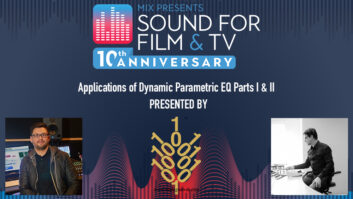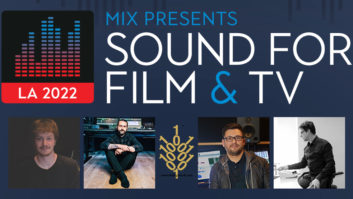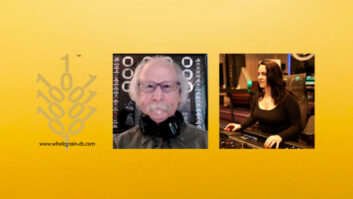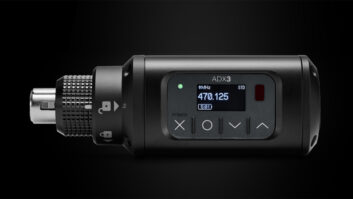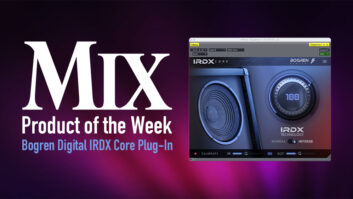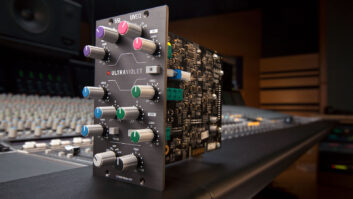
The Z-System’s Z-Qualizer is a half-rackspace, digital 2-channel mastering-grade equalizer with AES/EBU digital I/O only — no analog. Each channel in this very fine-sounding unit has high and low shelving, plus four overlapping fully parametric bands. As you’d expect, you can link the two channels for stereo operation or set them individually.
The Z-Qualizer uses the same algorithms as Z-Sys’ higher-end z-Q2 and z-Q6 models: It was designed to bring a quality product to a moderate price point. Therefore, it’s a fairly spartan unit, with a one-line LED and no metering or on/off switch. You just have to trust that its 40-bit engine is not going to overload internally, and, in fact, I wasn’t able to distort it audibly; all systems are go when the signal LED tells you it’s receiving a valid digital input.
Apart from the AES/EBU digital XLRs (the test unit was screened with the in and out labels reversed) and a connector for the unit’s wall wart power transformer, the only thing on the back panel is MIDI I/O for receiving patch changes or loading and dumping the unit’s 99 storage slots. There’s no word clock in or out; the unit clocks to an incoming 16- or 24-bit AES/EBU (or S/PDIF) signal at sample rates up to 96 kHz. I ran it at 24-bit/44.1 for this review.
One nice value-added feature is the Z-Qualizer’s ability to encode and/or decode M/S stereo signals. Among other applications, this lets you EQ and adjust the mid-signal independently of the sides in an M/S recording. But the most interesting application is using it as an effect, playing around with the width of a stereo mix by adjusting the difference signal’s level and timbre.
EQUALIZING WITH ROOM TO GROW
Using the Z-Qualizer is simple, and as it is a scaled-down high-end unit, it doesn’t present you with the usual frilly set of controls. You can bypass the whole unit, but there aren’t individual on/off switches for each band — you have to spin the knobs and zero the controls to make an A/B comparison.
Unlike their analog counterparts, digital equalizers’ controls aren’t continually adjustable, although the fact that I heard no zippering implies that the Z-Qualizer interpolates between settings. It allows progressively fine adjustments as you get closer to unity gain. When you’re within 12 dB (the maximum boost), for example, the increments are 0.1 dB; by the time you get to the -20 to -50dB range, the increments go up to 3 dB.
The same business applies to the Q and center frequency settings, although the latter is calibrated evenly in 1/6-octave steps from 28 to 20k Hz. This is a whole step, of course, and that’s pretty surgical. Despite being a little closely packed, the stepped encoders are set to make very precise adjustments easy. Moving the gain encoder from 9 o’clock to 12 o’clock only increases the boost about 1.2 dB. I did not hear any glitches when moving the controls.
This makes sense for a mastering equalizer, although the other side of the coin is that it takes a lot of twisting to make broad adjustments. I timed it taking just under five seconds to go from +5 to 0 dB as fast as I could. A nice addition would be velocity-sensitive encoders or perhaps encoders that you can push to jump larger increments, as would some kind of zeroing command.
Bear in mind that any minor ergonomic considerations are completely overshadowed by the Z-Qualizer’s sound quality. Z-Sys is known for its attention to digital details, so it’s no surprise that this equalizer sounds so transparent and smooth. The bitscope in Metric Halo’s SpectraFoo confirms that it actually truncates to the number of output bits you’ve set, with or without dither.
If you’re going to 16-bit/44.1 or 48, then you can use one of two types of POW-r dither instead of Z-Sys’ “carefully randomized floating-point dither.” You can also dither to 24 bits from the internal 32-bit floating-point processing.
A STAR IN THE STUDIO
The first thing you notice about the Z-Qualizer is that you don’t notice it: It’s extremely transparent. You can even use it on complicated sounds like sampled strings without hearing any phase problems at all. I ran several mixes through the unit in a digital send/return loop from a Pro Tools system, trying everything from typical mastering EQ shifts to precise radical surgery (reducing an obnoxious, dominant clave part from a coincident stereo recording). It has none of the hard plastic sound you hear in some of the less-distinguished EQ plug-ins, and at subtle boost settings, I found myself looking at it to make sure it wasn’t bypassed.
The closest equivalent plug-in to the Z-Qualizer is the Linear Equalizer in Waves’ Masters Bundle, which sounds similarly excellent. For a true comparison, I ran the mixes through the analog equalizers in a pair of Millennia Media STT-1 channel strips, well known to be among the best available. The outcome was very interesting: While the analog EQ does have a pleasing, round sound in the lows through upper-mids, the difference was more subtle than expected with the Millennias in their solid-state rather than tube settings. I didn’t prefer one processor over another to bring out air in a mix in the upper frequencies; neither of them was harsh nor unpleasant.
Despite the simplistic nature of the interface, the Z-Qualizer sounds outstanding and its M/S features are really useful. At $1,200, this is one to check out if you’re looking for mastering-quality digital equalization without spending a king’s ransom.
Z-Systems, 352/371-0990, fax: 352/371-0093, www.z-sys.com.
Nick Batzdorf, an L.A.-based music and audio technology writer/composer/engineer/producer, has most recently been writing music for on-air promotion.
